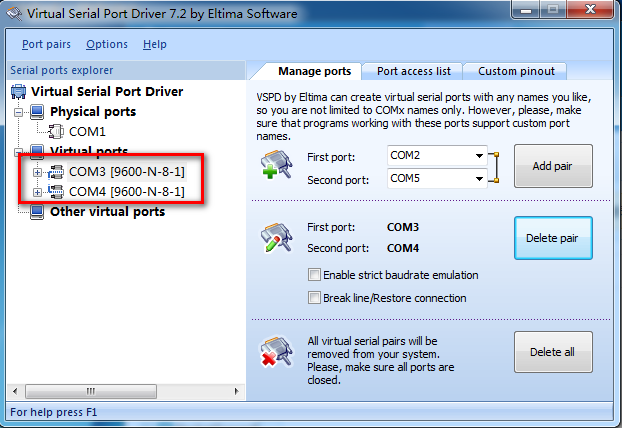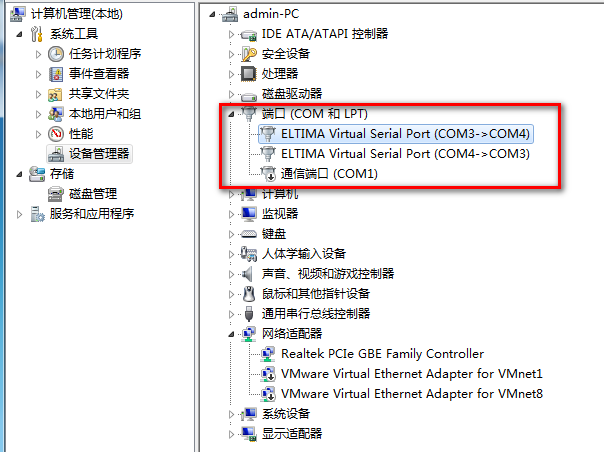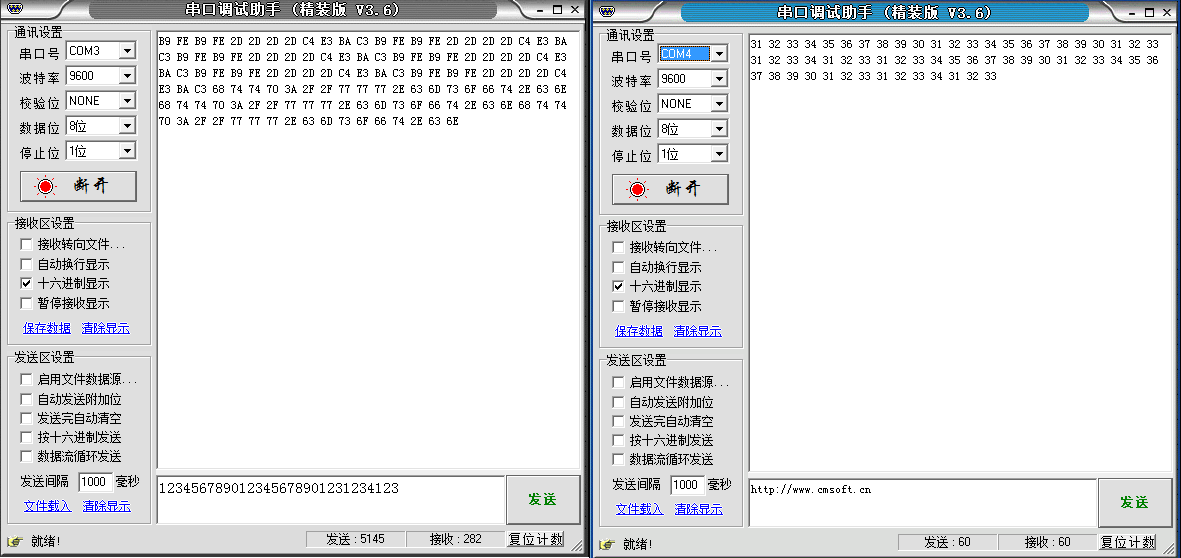 Java
Java
 javaTutorial
javaTutorial
 Implementation and debugging of communication between Java program and serial port
Implementation and debugging of communication between Java program and serial port
Implementation and debugging of communication between Java program and serial port
The following is an introduction to the editor’s latest project, which involves the implementation and debugging of the serial port communication part.
Serial communication principle
Serial communication refers to the serial port sending and receiving bytes bit by bit. Although slower than byte-by-byte parallel communication, a serial port can send data on one wire while receiving data on another wire.
Serial port is a very common device communication protocol on computers (not to be confused with Universal SerialBus or USB)
Typically, serial port is used for the transmission of ASCII code characters. Communication is done using 3 wires: (1) ground, (2) transmit, (3) receive. Because serial communication is asynchronous, a port can send data on one line while receiving data on another line. The other lines are used for handshaking, but are not required. The most important parameters for serial communication are bit rate, data bits, stop bits and parity. For two ports to communicate, these parameters must match
RS-232 (ANSI/EIA-232 standard) is a serial connection standard on IBM-PC and its compatible machines, RS-422 (EIA RS-422-AStandard) It is the serial port connection standard for Apple's Macintosh computers. RS-485 (EIA-485 standard) is an improvement of RS-422.
Complete the preparation work required for serial port communication and debugging on a computer
Since there are basically no paired serial ports on laptops or desktops for us to debug, we need to download virtual serial port software to achieve serial port debugging.
Download the virtual serial port software http://pan.baidu.com/s/1hqhGDbI (the one provided here is relatively easy to use). After the download and installation is completed, don’t rush to run it. Copy the vspdctl.dll file in the compressed package to the installation directory, such as: My directory is –>D:SoftWareInstallVirtual Serial Port Driver 7.2. Replace the original file and activate successfully.
Open the software to add virtual serial ports, which are usually added in pairs (add COM3, COM4) as shown in the picture:

After the addition is completed, check it in the device manager and find that there are two more virtual serial ports, such as Picture:

Download the serial port debugging software http://pan.baidu.com/s/1c0AVaXq The debugging software provided here is relatively old, but it is still relatively easy to use. Just unzip it and click to open it.
You can directly open two debugging windows first, which are used to represent the COM3 and COM4 serial ports respectively. The parameters of the two serial ports must be set the same to send and receive data normally. (If debugging can send and receive data normally, you can turn off a debugger and use a java program instead) As shown in the figure:

java program code writing
This part will be our focus. To communicate with the serial port, we must first Add the RXTXcomm.jar package to the project (place it in the lib directory in the project and add it to the build Path) (win64-bit download address: http://pan.baidu.com/s/1o6zLmTc); in addition, you also need to The decompressed rxtxParallel.dll and rxtxSerial.dll files are placed in the %JAVA_HOME%/jre/bin directory so that the package can be loaded and called normally.
Program code analysis:
package comm;
import java.io.*;
import java.util.*;
import java.util.concurrent.BlockingQueue;
import java.util.concurrent.LinkedBlockingQueue;
import gnu.io.*;
public class ContinueRead extends Thread implements SerialPortEventListener { // SerialPortEventListener
// 监听器,我的理解是独立开辟一个线程监听串口数据
static CommPortIdentifier portId; // 串口通信管理类
static Enumeration<?> portList; // 有效连接上的端口的枚举
InputStream inputStream; // 从串口来的输入流
static OutputStream outputStream;// 向串口输出的流
static SerialPort serialPort; // 串口的引用
// 堵塞队列用来存放读到的数据
private BlockingQueue<String> msgQueue = new LinkedBlockingQueue<String>();
@Override
/**
* SerialPort EventListene 的方法,持续监听端口上是否有数据流
*/
public void serialEvent(SerialPortEvent event) {//
switch (event.getEventType()) {
case SerialPortEvent.BI:
case SerialPortEvent.OE:
case SerialPortEvent.FE:
case SerialPortEvent.PE:
case SerialPortEvent.CD:
case SerialPortEvent.CTS:
case SerialPortEvent.DSR:
case SerialPortEvent.RI:
case SerialPortEvent.OUTPUT_BUFFER_EMPTY:
break;
case SerialPortEvent.DATA_AVAILABLE:// 当有可用数据时读取数据
byte[] readBuffer = new byte[20];
try {
int numBytes = -1;
while (inputStream.available() > 0) {
numBytes = inputStream.read(readBuffer);
if (numBytes > 0) {
msgQueue.add(new Date() + "真实收到的数据为:-----"
+ new String(readBuffer));
readBuffer = new byte[20];// 重新构造缓冲对象,否则有可能会影响接下来接收的数据
} else {
msgQueue.add("额------没有读到数据");
}
}
} catch (IOException e) {
}
break;
}
}
/**
*
* 通过程序打开COM4串口,设置监听器以及相关的参数
*
* @return 返回1 表示端口打开成功,返回 0表示端口打开失败
*/
public int startComPort() {
// 通过串口通信管理类获得当前连接上的串口列表
portList = CommPortIdentifier.getPortIdentifiers();
while (portList.hasMoreElements()) {
// 获取相应串口对象
portId = (CommPortIdentifier) portList.nextElement();
System.out.println("设备类型:--->" + portId.getPortType());
System.out.println("设备名称:---->" + portId.getName());
// 判断端口类型是否为串口
if (portId.getPortType() == CommPortIdentifier.PORT_SERIAL) {
// 判断如果COM4串口存在,就打开该串口
if (portId.getName().equals("COM4")) {
try {
// 打开串口名字为COM_4(名字任意),延迟为2毫秒
serialPort = (SerialPort) portId.open("COM_4", 2000);
} catch (PortInUseException e) {
e.printStackTrace();
return 0;
}
// 设置当前串口的输入输出流
try {
inputStream = serialPort.getInputStream();
outputStream = serialPort.getOutputStream();
} catch (IOException e) {
e.printStackTrace();
return 0;
}
// 给当前串口添加一个监听器
try {
serialPort.addEventListener(this);
} catch (TooManyListenersException e) {
e.printStackTrace();
return 0;
}
// 设置监听器生效,即:当有数据时通知
serialPort.notifyOnDataAvailable(true);
// 设置串口的一些读写参数
try {
// 比特率、数据位、停止位、奇偶校验位
serialPort.setSerialPortParams(9600,
SerialPort.DATABITS_8, SerialPort.STOPBITS_1,
SerialPort.PARITY_NONE);
} catch (UnsupportedCommOperationException e) {
e.printStackTrace();
return 0;
}
return 1;
}
}
}
return 0;
}
@Override
public void run() {
// TODO Auto-generated method stub
try {
System.out.println("--------------任务处理线程运行了--------------");
while (true) {
// 如果堵塞队列中存在数据就将其输出
if (msgQueue.size() > 0) {
System.out.println(msgQueue.take());
}
}
} catch (InterruptedException e) {
// TODO Auto-generated catch block
e.printStackTrace();
}
}
public static void main(String[] args) {
ContinueRead cRead = new ContinueRead();
int i = cRead.startComPort();
if (i == 1) {
// 启动线程来处理收到的数据
cRead.start();
try {
String st = "哈哈----你好";
System.out.println("发出字节数:" + st.getBytes("gbk").length);
outputStream.write(st.getBytes("gbk"), 0,
st.getBytes("gbk").length);
} catch (IOException e) {
// TODO Auto-generated catch block
e.printStackTrace();
}
} else {
return;
}
}
}Java program and serial port communication debugging
Program debugging screenshots:

Summary
Serial port communication is used in many places, especially embedded development, SMS module development and for All kinds of hardware product customization software are needed. Among them, the most commonly used communication protocol is the RS-232 communication protocol. If you want to become a real serial communication development master, you need to fully understand the serial communication protocol (I am still a novice... I hope an expert can give guidance).
Another focus of serial communication is how to determine the type of data and extract valid data after receiving the data. These need to be coded according to the corresponding protocol.
For more articles related to communication implementation and debugging between Java programs and serial ports, please pay attention to the PHP Chinese website!

Hot AI Tools

Undresser.AI Undress
AI-powered app for creating realistic nude photos

AI Clothes Remover
Online AI tool for removing clothes from photos.

Undress AI Tool
Undress images for free

Clothoff.io
AI clothes remover

AI Hentai Generator
Generate AI Hentai for free.

Hot Article

Hot Tools

Notepad++7.3.1
Easy-to-use and free code editor

SublimeText3 Chinese version
Chinese version, very easy to use

Zend Studio 13.0.1
Powerful PHP integrated development environment

Dreamweaver CS6
Visual web development tools

SublimeText3 Mac version
God-level code editing software (SublimeText3)

Hot Topics
 1377
1377
 52
52
 How does Java's classloading mechanism work, including different classloaders and their delegation models?
Mar 17, 2025 pm 05:35 PM
How does Java's classloading mechanism work, including different classloaders and their delegation models?
Mar 17, 2025 pm 05:35 PM
Java's classloading involves loading, linking, and initializing classes using a hierarchical system with Bootstrap, Extension, and Application classloaders. The parent delegation model ensures core classes are loaded first, affecting custom class loa
 How do I implement multi-level caching in Java applications using libraries like Caffeine or Guava Cache?
Mar 17, 2025 pm 05:44 PM
How do I implement multi-level caching in Java applications using libraries like Caffeine or Guava Cache?
Mar 17, 2025 pm 05:44 PM
The article discusses implementing multi-level caching in Java using Caffeine and Guava Cache to enhance application performance. It covers setup, integration, and performance benefits, along with configuration and eviction policy management best pra
 How can I use JPA (Java Persistence API) for object-relational mapping with advanced features like caching and lazy loading?
Mar 17, 2025 pm 05:43 PM
How can I use JPA (Java Persistence API) for object-relational mapping with advanced features like caching and lazy loading?
Mar 17, 2025 pm 05:43 PM
The article discusses using JPA for object-relational mapping with advanced features like caching and lazy loading. It covers setup, entity mapping, and best practices for optimizing performance while highlighting potential pitfalls.[159 characters]
 How do I use Maven or Gradle for advanced Java project management, build automation, and dependency resolution?
Mar 17, 2025 pm 05:46 PM
How do I use Maven or Gradle for advanced Java project management, build automation, and dependency resolution?
Mar 17, 2025 pm 05:46 PM
The article discusses using Maven and Gradle for Java project management, build automation, and dependency resolution, comparing their approaches and optimization strategies.
 How do I create and use custom Java libraries (JAR files) with proper versioning and dependency management?
Mar 17, 2025 pm 05:45 PM
How do I create and use custom Java libraries (JAR files) with proper versioning and dependency management?
Mar 17, 2025 pm 05:45 PM
The article discusses creating and using custom Java libraries (JAR files) with proper versioning and dependency management, using tools like Maven and Gradle.



